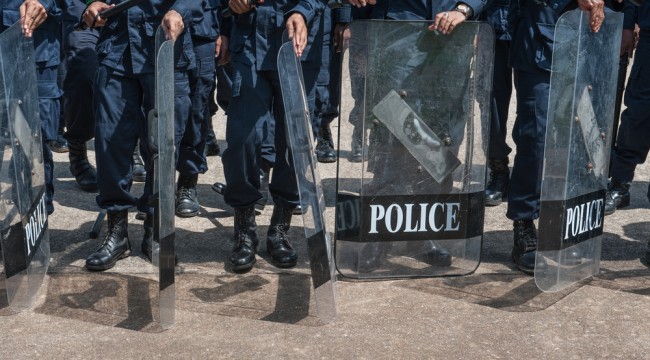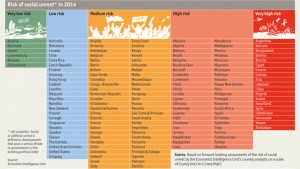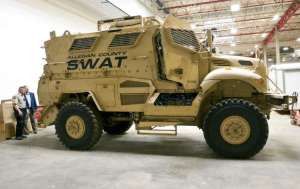Social Unrest is Here to Stay: Here's How to Protect Yourself
Social unrest has been bubbling to the surface of the news all over the country, and all over the world.
Earlier this month marked the one-year anniversary of the death of Michael Brown in Ferguson, Missouri in August 2014.
It happened in Taylor, Michigan over an unexpected shortage of Section 8 housing vouchers in 2013.
It happened in New York City over the death of Eric Garner in July 2014.
And just this past April it happened right here in Baltimore over the police brutality and subsequent death of Freddie Gray.
The world seems to be becoming a much more dangerous, unsettled place lately, and in these uncertain times, violence born of debt, frustration, and politics could strike at any minute.
In the United States alone, there have been over ten instances of social unrest and rioting in the past two years.
But this problem isn’t limited to the good ol’ U.S. of A.
Even cities traditionally seen as more placid, like Singapore, have seen demonstrators taking to the streets — typically spurred by social inequalities and political discontent.
Check out the video below, in which Singapore watched in disbelief as 400 foreign workers caused a damaging riot in 2013.
As it says in the clip, the city’s police commissioner had never seen rioting on Singapore streets in his 26 years as an officer, and citizens debated over social media why the riots started, speculating that the low-paid foreign workers acted out of desperation.
Not to mention, mass uprising and resistance is now easier to coordinate than ever before with smartphones and social media. Technology isn’t slowing down any time soon, and with political and economic tensions on the rise worldwide, every savvy citizen must wonder: where will social unrest erupt next year?
The Economist Intelligence Unit measures the risk of social unrest in 150 countries around the world, and places a heavy emphasis on institutional and political weaknesses.
According to its ratings, 65 countries (43% of the 150) were at a high or very high risk of social unrest in 2014. Compared with five years prior, 19 more countries are now in the high-risk categories.
If you’re reading this and thinking yeah, sure, there have been a few riots here and there, but it’s nothing more than a fluke or strategic media coverage. But don’t be a skeptic — potentially damaging and dangerous social unrest is coming to a town near you.
In an op-ed entitled “The Pitchforks Are Coming… For Us Plutocrats,” billionaire and venture capitalist Nick Hanauer taps into that very notion of “it’ll never happen to me.” He writes:
Many of us think we’re special because “this is America.” We think we’re immune to the same forces that started the Arab Spring—or the French and Russian revolutions, for that matter.
Here’s what I say to you: You’re living in a dream world.
What everyone wants to believe is that when things reach a tipping point and go from being merely crappy for the masses to dangerous and socially destabilizing, that we’re somehow going to know about that shift ahead of time.
Any student of history knows that’s not the way it happens. Revolutions, like bankruptcies, come gradually, and then suddenly. One day, somebody sets himself on fire, then thousands of people are in the streets, and before you know it, the country is burning.
It’s time for us to wake up and smell the civil strife, folks!
In an article on The New American titled “Prediction: Economic Collapse, Civil Unrest in America by 2016,” author Selwyn Duke echoes the same sentiment, writing:
Violence. Rioting. Looting. Economic collapse and civil unrest. This isn’t a dystopian movie plot, but something else according to an economist with a good track record for prognostication: America’s dark future.
The economist is Martin Armstrong, whose correct predictions include the 1987 Black Monday crash and the 1998 Russian financial implosion. And now he’s predicting civil unrest in America by 2016, precipitated by an economic collapse which he calls “the magic ingredient.” “Turn the economy down,” he continued, “and you get civil unrest and revolution.”
And what would precipitate our economic collapse? Many observers have warned that our runaway spending and loose monetary policy constitute a ticking time-bomb… Of course, some will say that the United States isn’t Hungary or Zimbabwe. But we should seriously wonder what we will be tomorrow if we won’t stop digging an economic grave with credit cards, counterfeit cash, and covetousness cloaked in compassion.
In 2009, government debt in Britain was fast on the rise, and after a tax raise and spending cuts, a riot broke out at the Bank of England. The Telegraph reports:
In a sombre report on the outlook for next year, the credit rating agency raised the prospect that future tax rises and spending cuts could trigger social unrest in a range of countries from the developing to the developed world.
It said that in the coming years, evidence of social unrest and public tension may become just as important signs of whether a country will be able to adapt as traditional economic metrics. Signaling that a fiscal crisis remains a possibility for a leading economy, it said that 2010 would be a “tumultuous year for sovereign debt issuers.”
The article goes on to explain that the sheer quantities of debt from leading nations would increase social tensions and the risk of investor fright. Countries with rapidly increasing debt need to rein in their deficits, which will almost certainly test social cohesion.
Consider the Greek debt crisis of this past June. After defaulting on a $1.73 billion payment to the IMF and closing off banks, sever rioting and social unrest broke out. In an article titled “4 Alarming Reasons American Could Be The Next Greece” author Daniel Jennings details the specific ways Uncle Sam could be following in Greece’s footsteps:
The financial crisis in Greece should be a wakeup call for Americans, as there are some disturbing parallels between that European country and the US.
Debt and other economic problems could destroy American independence just as they undermined Greece’s status as a nation.
Those who don’t believe America could share Greece’s fate need to take a look at some disturbing trends in the US economy. America, sadly, is repeating some of the same mistakes that destroyed Greece’s.
Below is a quick summary of Jennings’ four reasons:
- America is accumulating more debt than it could ever possibly pay off, just like Greece
- America spends most of its money on entitlements, just like Greece
- Too many American citizens are dependent on the government for benefits, just like in Greece
- America is experiencing economic stagnation, just like Greece
This clip paints a lovely picture of what could happen in your neighborhood or country if it faces a similar situation to Greece.
Nationalinterest.org also believe America could become the next Greece — considering the fiscal pressures confronting the United States spring from sources similar to those afflicting Greece:
Growing spending on public benefits threatens to overwhelm the U.S. economy in the long term. At the federal level, Social Security, Medicare, Medicaid and other health programs consume more than half of the budget, and spending on these programs is growing steeply. After accounting for other benefits, transfer payments make up about 70 percent of all spending in the United States today.
Implementing important reforms to unaffordable and outdated benefit programs has proved to be a difficult feat politically. However, waiting too long on reforms diminishes the ability to phase in major changes gradually, in a way that will protect those who rely on benefits the most and leave others time to adjust to new fiscal realities. Waiting for a major crisis to force reforms, as Greece has done, brings unnecessarily painful austerity.
Greece and other struggling European countries offer Americans a window to the future. If U.S. policy makers and the public take away only one key lesson from what’s happening in Europe right now, it should be to put the budget on a path to balance during good times such as these. The alternative is much, much worse.
It makes you wonder what kind of backlash might occur if and when Yellen and her cronies at the Federal Reserve finally decide to raise interest rates…
Which leads me to the question of why social unrest occurs in the first place.
There is a laundry list of reasons — anything from police brutality and abject poverty, to social inequality and the wage gap.
According to Laza Kekic from the Economist Intelligence Unit (EIU), economic distress is almost a prerequisite for protest, but does not explain outbursts entirely:
Declines in income and high unemployment are not always followed by unrest. Only when economic trouble is accompanied by other elements of vulnerability is there a high risk of instability.
Such factors include wide income-inequality, poor government, low levels of social provision, ethnic tensions and a history of unrest. Of particular importance in sparking unrest in recent times appears to have been an erosion of trust in governments and institutions: a crisis of democracy.
But it’s not necessarily going to be all angry mobs and pitchforks.
In today’s tech-obsessed world, there is more than one form of social unrest.
Sure, there are demonstrations in the streets, looting, and crime waves.
But there are also movements occurring in cyberspace that run amok in peoples’ lives and finances.
Perhaps the biggest confirmation of this social unrest theory is the extent to which local government and police have bulked up their equipment, firepower and technology.
Police in Michigan have already bulked up their operations with the military’s surplus equipment — which includes armored trucks, grenade launchers, and bayonets — all thanks to the Military Surplus program, which takes already-paid-for-by-taxpayers equipment and gives it to police agencies:
…many West Michigan police agencies have become better equipped to handle both violent incidents and disasters, thanks to the U.S. military.
Since about 1990, police have been able to acquire military surplus through the federal government via the 1033 Program.
But it wasn’t until late 2014 that the Pentagon began releasing detailed information about the surplus items going to police agencies across the nation.
The chaos in Ferguson, Missouri, as heavily armed police using armored equipment clashed with protesters over the Michael Brown shooting last year, led to calls for transparency about police agencies and their military surplus.
In Michigan, what the data showed was a large release of armored vehicles going to law enforcement, mostly between 2011 and 2014.
Even before the unrest in Ferguson, the American Civil Liberties Union last June raised concerns about police using surplus SWAT-type vehicles for seemingly routine operations.
A MRAP, or Mine Resistant Ambush Protected vehicle, inside the Allegan County Sheriff’s Department. Seems totally necessary, right?
This trend toward increased militarization of domestic police, combined with government contingency plans like Rex 84, should perk up a few ears.
Rex 84, or the Readiness Exercise 1984, “outlines continuity of government wherein the US Constitution is suspended, martial law is declared and the US military command take over state and local governments in order to ensure stabilization of our nation at any cost. Any American who is deemed a “national security threat” would be detained in an interment or FEMA camp.”
To give you an idea — Rex 84 has only been implemented twice before: during the Los Angeles riots and on 9/11.
And what about the Jade Helm 15 Military Training Exercise that began this past July?
This is a seven-state, months-long U.S. military exercise, but, due to the fact it’s one of the largest military training exercises ever performed on domestic soil, many people believe it’s a cover for an impending military takeover and the establishment of martial law.
So we’re dealing with a mixed bag of social unrest tactics here, but one thing’s for sure: social unrest is here to stay. You should prepare.
One of the first things you can do is ensure that you and your family will be able to provide for yourselves without depending on others.
This means stockpiling some survival essentials to protect yourself from whatever problems may come down the road after an outbreak of social unrest, violence, robberies, home invasions, rioting, or worse.
Laissez-Faire Book’s “Family Survival Blueprint,” agrees, writing:
Not only has the financial, economic and social fallout of the 2008 crash remained present… many analysts are predicting an even worse meltdown coming in the near future.
If a serious financial calamity hits us soon, most americans will be caught helpless. store shelves will be cleared within hours… gas stations within days… and even police departments, government offices and major infrastructure may collapse within weeks or months.
The Survival Blueprint provides a list of the 7 essential items you’re going to want to keep you and your family safe:
- Water: no brainer — keeps you healthy and functional, and in dire cases can be used as currency
- Food: water keeps you hydrated, but food keeps you alert and functional
- Clothing: consider clothes you would pack for hiking or camping
- Shelter: stock up on a tent and/or supplies to build a reliable shelter
- First-aid kit: when the world is unraveling into chaos, you don’t want a small cut to lead to a life-threatening infection
- Basic Gear: matches, flashlight, batteries, a knife, etc.
- Weapons: if things get really, truly bad, things will get dangerous — a gun is probably your best bet, but if your state or country won’t allow that, a knife or club will suffice
If you’re looking for a more practical, less apocalyptic suggestion, Jim Rickards recommends buying a “Monster Box” issued by the U.S. Mint:
You can buy them through reputable precious metals dealers. A Monster Box is a sealed container of 500 1-ounce pure silver American Silver Eagle coins. The box is colored “Treasury green.”
You should not break the seal on the box unless you actually need the coins for transactions. The price varies with the market, but one box would be about $8,000 plus a small commission based on the current price of silver.
This is not only a good store of wealth, but the coins will prove useful for shopping and smaller transactions in the event the power grid and banking systems break down in a future financial crisis or natural disaster. You can store the Monster Box in a reputable nonbank vault or in a home safe — just don’t let anyone know you have it.
With our country’s “tomorrow” looking bleaker than ever before, do yourself — and your wealth — a favor and by preparing for impeding social unrest in your town. Remember, the prepared are spared.
À tout à l’heure,
Genevieve LeFranc
for The Daily Reckoning
P.S. When you sign up for the Daily Reckoning, you will receive just that; timely and entertaining ideas everyday that will help you understand how markets work. Did I mention it’s free? Because it is! Sign up here today to start receiving the Daily Reckoningto your inbox, completely free of charge.





Comments: